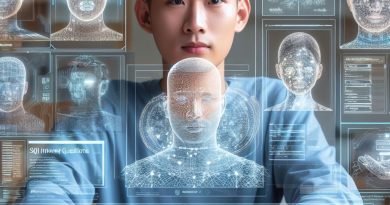How Coding Drives Artificial Intelligence and ML
Last Updated on January 27, 2024
Introduction
In this section, we will explore how coding plays a crucial role in driving Artificial Intelligence (AI) and Machine Learning (ML).
Coding, also known as programming, is the process of writing instructions for computers to execute specific tasks.
The relevance of coding lies in its ability to create software, algorithms, and models that power AI and ML systems.
Artificial Intelligence refers to the development of computer systems capable of performing tasks that typically require human intelligence.
Machine Learning is a subset of AI that involves training computers to learn from data and improve their performance over time without explicit programming.
Coding is the backbone of AI and ML, as it enables programmers to develop and design algorithms and models.
These algorithms and models enable AI systems to analyze vast amounts of data, recognize patterns, and make autonomous decisions.
With coding, programmers can write the logic and rules that govern the behavior of AI systems and drive their decision-making processes.
Furthermore, coding is essential for the development of ML algorithms that learn from data, make predictions, and continuously adapt.
Generally, coding is a fundamental aspect of AI and ML, enabling the development and implementation of intelligent systems that can learn, reason, and make decisions.
The Role of Coding in AI
Coding plays a crucial role in the creation and development of Artificial Intelligence (AI) systems.
It serves as the foundation for building AI, enabling machines to perform various tasks and make independent decisions.
Explanation of how coding is essential for creating AI systems
- Coding allows AI programmers to define the rules, algorithms, and data processing methods that AI systems utilize.
- It serves as a means to input the necessary logic and instructions for AI systems to function effectively.
- With coding, AI systems can understand and interpret input data, perform computations, and generate output or responses.
- It provides the framework for training AI models by feeding them with vast amounts of data and helping them learn over time.
Discussion of how coding enables AI to perform tasks and make independent decisions:
Coding enables AI systems to perform a wide range of tasks and make decisions independently, which are two key aspects of their functionality.
- Through coding, AI systems can analyze large datasets at incredible speeds, allowing them to identify patterns, trends, and correlations.
- With this ability, they can provide accurate predictions, automate repetitive tasks, and assist humans in complex decision-making processes.
- By applying advanced algorithms through coding, AI systems can adapt and improve their performance based on changing conditions and new data.
- Coding empowers AI systems to process natural language, enabling them to understand, interpret, and respond to human speech or written text.
Examples of coding languages commonly used in AI development
There are several programming languages that are widely used in the development of AI systems.
Some popular languages include:
- Python: Known for its simplicity and versatility, Python is widely used in AI development due to its extensive libraries and frameworks.
- Java: A robust and platform-independent language, Java is often used in AI projects that require scalability and high-performance computing.
- C++: Commonly used when optimizing AI systems, C++ provides low-level control and efficient memory management.
- R: Specially designed for statistical analysis and data manipulation, R is favored by data scientists in the AI field.
In a nutshell, coding plays an essential role in driving Artificial Intelligence and Machine Learning.
Coding forms the foundation for building AI systems, enabling them to perform tasks, make independent decisions, and adapt to new information.
Additionally, various coding languages provide programmers with the tools necessary to develop and optimize AI systems for different applications and scenarios.
Read: CodeIgniter Security Features You Should Know About
Coding in Machine Learning
- Coding is pivotal in ML, responsible for algorithm creation and implementation.
- Data preprocessing involves cleaning, transforming, and normalizing data for better analysis.
- Feature engineering enhances model performance by creating new features from existing ones.
- Model training selects and trains ML models on the data.
- Popular coding libraries include TensorFlow, PyTorch, and scikit-learn.
- TensorFlow simplifies designing and training ML models.
- PyTorch offers dynamic computation and GPU support.
- scikit-learn provides tools for data mining and analysis.
- Coding selects algorithms like linear regression, decision trees, and neural networks.
- Linear regression relates input variables to continuous output.
- Decision trees make decisions based on input values.
- Neural networks learn complex patterns from data.
- Hyperparameter tuning optimizes model performance.
- It adjusts parameters like learning rate and batch size.
- Large datasets and distributed computing techniques are essential in ML.
- GPU utilization and frameworks like Apache Spark are common for efficient processing.
- Coding empowers ML algorithms to learn, make predictions, and improve continuously.
- Evolving coding techniques and libraries advance AI and ML capabilities.
Read: From Coding Camp to Career: Real Success Stories

Delve into the Subject: The Anatomy of a Viral Coding Meme: A Case Study
Coding in AI Applications
Overview of various AI applications and how coding is involved
Artificial Intelligence (AI) has become increasingly prominent in a wide range of applications across different industries.
From healthcare to finance to transportation, the power of AI is transforming the way we live and work.
At the heart of all AI applications is coding, the process of instructing machines to perform complex tasks.
In healthcare, AI technologies are being utilized for medical diagnosis, drug discovery, and patient monitoring.
Coding plays a crucial role in training AI systems to recognize patterns in medical data, making accurate diagnoses, and suggesting treatment plans.
By using algorithms and coding techniques, AI can process vast amounts of patient records and medical literature, assisting doctors in making informed decisions.
In the financial sector, coding is used to develop AI systems that can analyze market data, predict trends, and automate trading processes.
By leveraging coding and machine learning techniques, these AI systems can process large volumes of financial data in real-time and make intelligent investment decisions.
This not only increases efficiency but also minimizes the risks associated with human error.
Transportation is another area where coding is driving AI applications.
Self-driving cars, for example, rely on complex algorithms and coding to interpret sensor data and navigate through traffic.
Through deep learning algorithms and coding techniques, these AI systems continuously learn from their environment, enhancing their ability to make safe and informed driving decisions.
Explanation of how coding is used to train AI systems in different domains
In various domains, coding actively trains AI systems by providing extensive data and teaching them pattern recognition and prediction skills.
This process, known as machine learning, involves coding algorithms that enable AI systems to learn from experience.
In healthcare, for instance, AI systems are trained by providing them with medical records, images, and scientific literature.
By coding algorithms that can identify relevant features in these data sets, AI systems can learn to diagnose diseases, identify risk factors, and recommend personalized treatment plans.
Financial experts train AI systems with historical market data, coding algorithms to identify patterns and predict future trends.
By analyzing large volumes of data and identifying correlations, these AI systems can make accurate predictions about stock prices, interest rates, and market fluctuations.
In transportation, AI systems are trained using sensor data from real-world driving scenarios.
By coding algorithms that can interpret this data and make driving decisions, AI systems can learn to navigate through traffic, recognize traffic signs, and respond to unpredictable situations on the road.
Illustration of real-world AI projects and the coding techniques used in their development
Let’s take a closer look at some real-world AI projects and the coding techniques used in their development:
- Google’s AlphaGo: This AI system, which defeated the world champion Go player, was trained using a technique called deep reinforcement learning.
By coding algorithms that allowed the system to learn from its own gameplay, AlphaGo achieved superhuman performance in the game. - IBM Watson: Watson, the AI system developed by IBM, has been used in various domains, including healthcare and finance.
By coding natural language processing algorithms, Watson can understand and analyze unstructured data, such as medical literature or financial reports, providing valuable insights to professionals. - Tesla’s Autopilot: Tesla’s self-driving system utilizes a combination of computer vision and machine learning techniques.
By coding algorithms that can process sensor data and recognize objects, Autopilot can navigate highways, change lanes, and park the car autonomously.
These examples illustrate how coding drives AI and machine learning. With the right algorithms and coding techniques, AI systems can learn from data, make predictions, and perform complex tasks across various domains.
Therefore, coding plays a fundamental role in AI applications.
Whether it’s in healthcare, finance, or transportation, coding is essential for training AI systems, enabling them to process data, recognize patterns, and make intelligent decisions.
As we continue to advance in AI technology, coding will continue to be a pivotal skill in shaping the future of AI and its impact on our lives.
Read: Coding Camp for Girls: Bridging the Gender Gap in Tech
The Future of Coding and AI
Discussion on the potential impact of coding on AI advancements
- Coding plays a crucial role in driving the development of Artificial Intelligence (AI) and Machine Learning (ML).
- Coding enables the creation and training of AI algorithms to process extensive data and make predictions or decisions.
- As coding techniques improve, so does the accuracy and efficiency of AI systems.
- Coding allows programmers to implement complex algorithms that enable AI to perform tasks traditionally done by humans.
Exploration of emerging coding techniques and practices in AI development
- Developers are constantly exploring new coding techniques to enhance AI capabilities.
- One example is the use of deep learning, a coding method that mimics the human brain’s neural networks.
- Deep learning algorithms can analyze unstructured data such as images, text, and speech, leading to better AI performance.
- Coding practices such as reinforcement learning enable AI systems to learn and improve through trial and error.
Speculation on the future possibilities and challenges in coding for AI
- The future holds great potential for coding in the advancement of AI.
- With improved coding techniques, AI could revolutionize various industries, including healthcare, finance, and transportation.
- However, there are challenges to overcome, such as ethical considerations and potential biases in AI algorithms.
- Coding for AI also requires a multidisciplinary approach, combining expertise in coding, data science, and domain knowledge.
Most importantly, coding is the driving force behind AI and ML. It enables the development of sophisticated algorithms and facilitates the training of AI systems.
Emerging coding techniques like deep learning and reinforcement learning are further enhancing AI capabilities.
In AI development, coding offers vast future possibilities, but we must address challenges related to ethics and biases.
The future of coding and AI holds immense potential for transforming industries and improving various aspects of human life.
Read: Why Winter Coding Camps Are Worth the Investment
Conclusion
Let’s recap the importance of coding in driving AI and ML. Coding is the backbone of AI and ML development.
It enables the creation of algorithms and models that power intelligent systems.
Without coding, AI and ML would not exist.
Furthermore, the synergy between coding, AI, and ML is undeniable.
Coding allows developers to implement AI and ML techniques, while AI and ML help improve coding practices by automating repetitive tasks.
In review, coding is not only vital but also exciting when it comes to AI and ML.
It opens up a world of possibilities for innovation and problem-solving.
Therefore, we encourage readers to explore coding in the context of AI and ML.
By doing so, they can contribute to the advancement of these cutting-edge technologies and shape the future.


